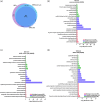Neuroprotective activity of a virus-safe nanofiltered human platelet lysate depleted of extracellular vesicles in Parkinson's disease and traumatic brain injury models
- PMID: 36684076
- PMCID: PMC9842020
- DOI: 10.1002/btm2.10360
Neuroprotective activity of a virus-safe nanofiltered human platelet lysate depleted of extracellular vesicles in Parkinson's disease and traumatic brain injury models
Abstract
Brain administration of human platelet lysates (HPL) is a potential emerging biotherapy of neurodegenerative and traumatic diseases of the central nervous system. HPLs being prepared from pooled platelet concentrates, thereby increasing viral risks, manufacturing processes should incorporate robust virus-reduction treatments. We evaluated a 19 ± 2-nm virus removal nanofiltration process using hydrophilic regenerated cellulose hollow fibers on the properties of a neuroprotective heat-treated HPL (HPPL). Spiking experiments demonstrated >5.30 log removal of 20-22-nm non-enveloped minute virus of mice-mock particles using an immuno-quantitative polymerase chain reaction assay. The nanofiltered HPPL (NHPPL) contained a range of neurotrophic factors like HPPL. There was >2 log removal of extracellular vesicles (EVs), associated with decreased expression of pro-thrombogenic phosphatidylserine and procoagulant activity. LC-MS/MS proteomics showed that ca. 80% of HPPL proteins, including neurotrophins, cytokines, and antioxidants, were still found in NHPPL, whereas proteins associated with some infections and cancer-associated pathways, pro-coagulation and EVs, were removed. NHPPL maintained intact neuroprotective activity in Lund human mesencephalic dopaminergic neuron model of Parkinson's disease (PD), stimulated the differentiation of SH-SY5Y neuronal cells and showed preserved anti-inflammatory function upon intranasal administration in a mouse model of traumatic brain injury (TBI). Therefore, nanofiltration of HPL is feasible, lowers the viral, prothrombotic and procoagulant risks, and preserves the neuroprotective and anti-inflammatory properties in neuronal pre-clinical models of PD and TBI.
Keywords: human platelet lysate; nanofiltration; neuroprotection; prion; virus.
© 2022 The Authors. Bioengineering & Translational Medicine published by Wiley Periodicals LLC on behalf of American Institute of Chemical Engineers.
Conflict of interest statement
Naoto Watanabe and Masayasu Takahara are employees of Asahi Kasei Medical. Thierry Burnouf and David Devos are named as inventors of patent applications owned by their respective universities and institutions and are founders of Invenis Biotherapies. The other authors have no commercial, proprietary, or financial interest in the products or companies described in this article.
Figures







Similar articles
-
Can the administration of platelet lysates to the brain help treat neurological disorders?Cell Mol Life Sci. 2022 Jun 24;79(7):379. doi: 10.1007/s00018-022-04397-w. Cell Mol Life Sci. 2022. PMID: 35750991 Free PMC article. Review.
-
Expanding applications of allogeneic platelets, platelet lysates, and platelet extracellular vesicles in cell therapy, regenerative medicine, and targeted drug delivery.J Biomed Sci. 2023 Sep 14;30(1):79. doi: 10.1186/s12929-023-00972-w. J Biomed Sci. 2023. PMID: 37704991 Free PMC article. Review.
-
Neuroprotective effects of intranasal extracellular vesicles from human platelet concentrates supernatants in traumatic brain injury and Parkinson's disease models.J Biomed Sci. 2024 Sep 5;31(1):87. doi: 10.1186/s12929-024-01072-z. J Biomed Sci. 2024. PMID: 39237980 Free PMC article.
-
Characterization and Chromatographic Isolation of Platelet Extracellular Vesicles from Human Platelet Lysates for Applications in Neuroregenerative Medicine.ACS Biomater Sci Eng. 2021 Dec 13;7(12):5823-5835. doi: 10.1021/acsbiomaterials.1c01226. Epub 2021 Nov 30. ACS Biomater Sci Eng. 2021. PMID: 34846835
-
Removal of minute virus of mice-mock virus particles by nanofiltration of culture growth medium supplemented with 10% human platelet lysate.Cytotherapy. 2021 Oct;23(10):902-907. doi: 10.1016/j.jcyt.2021.05.006. Epub 2021 Jul 5. Cytotherapy. 2021. PMID: 34238658
Cited by
-
Can the administration of platelet lysates to the brain help treat neurological disorders?Cell Mol Life Sci. 2022 Jun 24;79(7):379. doi: 10.1007/s00018-022-04397-w. Cell Mol Life Sci. 2022. PMID: 35750991 Free PMC article. Review.
-
Unraveling the Emerging Niche Role of Extracellular Vesicles (EVs) in Traumatic Brain Injury (TBI).CNS Neurol Disord Drug Targets. 2024;23(11):1357-1370. doi: 10.2174/0118715273288155240201065041. CNS Neurol Disord Drug Targets. 2024. PMID: 38351688 Review.
-
Platelet Dynamics in Neurodegenerative Disorders: Investigating the Role of Platelets in Neurological Pathology.J Clin Med. 2024 Apr 3;13(7):2102. doi: 10.3390/jcm13072102. J Clin Med. 2024. PMID: 38610867 Free PMC article. Review.
-
The value of platelet-rich plasma-derived extracellular vesicles in modern medicine.Ann Med. 2023 Dec;55(2):2287705. doi: 10.1080/07853890.2023.2287705. Epub 2023 Dec 8. Ann Med. 2023. PMID: 38065677 Free PMC article. Review.
-
Expanding applications of allogeneic platelets, platelet lysates, and platelet extracellular vesicles in cell therapy, regenerative medicine, and targeted drug delivery.J Biomed Sci. 2023 Sep 14;30(1):79. doi: 10.1186/s12929-023-00972-w. J Biomed Sci. 2023. PMID: 37704991 Free PMC article. Review.
References
LinkOut - more resources
Full Text Sources
Research Materials

